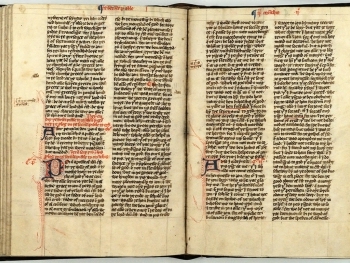The Authorized King James Version (AKJV), also known simply as the King James Version (KJV), is one of the most influential and widely recognized translations of the Bible in the English-speaking world. Commissioned in 1604 by King James I of England and first published in 1611, the AKJV has left an indelible mark on English literature, religion, and culture. This post delves into the historical context of its creation, its translation methodology, and its enduring legacy.
Historical Context
The early 17th century was a time of religious tension and political intrigue in England. The Puritan movement, which sought further reformation of the Church of England, was gaining momentum, and there was a desire for a new Bible translation that would be acceptable to various factions within Christianity. King James I, ascending to the throne in 1603, saw an opportunity to unify his kingdom religiously and politically by commissioning a new translation of the Bible.
In 1604, at the Hampton Court Conference, King James I authorized a new translation to address perceived issues in earlier translations, such as the Geneva Bible and the Bishops' Bible. The goal was to produce a version that would be both accurate and majestic in its language, suitable for reading in churches.
Translation Methodology
The translation of the AKJV was an extensive and collaborative effort involving around 47 scholars, divided into six committees, working in Westminster, Oxford, and Cambridge. These scholars were among the best linguists and theologians of their time, bringing expertise in Hebrew, Greek, and Latin.
Source Texts: The translators used a variety of source texts, including the Masoretic Text for the Old Testament, the Textus Receptus for the New Testament, and several earlier English translations. They also consulted texts in Latin, Syriac, and other languages to ensure accuracy.
Translation Principles: The AKJV was designed to be a "word-for-word" translation as much as possible, following the principle of formal equivalence. The translators aimed for a high degree of literalness, preserving the structure and wording of the original texts, while also ensuring the translation was readable and majestic in English.
Language and Style: The translators of the AKJV sought to use language that was both accessible and dignified. They were meticulous in their choice of words, striving for an elevated style that would be appropriate for public reading and memorization. The AKJV is known for its rhythmic and poetic quality, which has contributed to its lasting appeal.
Theological and Literary Impact
The AKJV has had a profound impact on both theology and literature. Its majestic prose and poetic rhythm have made it a lasting influence on the English language and literary tradition. Many of its phrases have entered common usage, and its style has been emulated in various literary works.
Theological Influence: The AKJV became the standard Bible for English-speaking Protestants for centuries. Its influence extended to doctrine, liturgy, and personal devotion. The translation's fidelity to the original texts and its majestic language reinforced the authority of Scripture in Protestant theology.
Literary Influence: The AKJV has significantly influenced English literature. Its phrases and idioms have permeated the works of authors such as John Milton, William Wordsworth, and Herman Melville. Its literary qualities have made it a subject of study not only for theologians but also for literary critics and historians.
Challenges and Criticisms
Despite its profound impact, the AKJV has faced criticisms and challenges over the centuries. Critics have pointed to certain translation choices that reflect the theological biases and limited knowledge of the translators' time. Moreover, advances in biblical scholarship and the discovery of older manuscripts have led to new translations that some argue are more accurate.
Translation Choices: Some critics have noted that certain translation choices in the AKJV were influenced by the theological and political context of the early 17th century. For example, the translation of certain Hebrew and Greek terms has been questioned for reflecting the Anglican Church's doctrines.
Manuscript Evidence: Since the publication of the AKJV, older and more reliable manuscripts of the Bible have been discovered, such as the Dead Sea Scrolls and Codex Sinaiticus. These discoveries have provided a more nuanced understanding of the biblical texts and have led to new translations that some scholars argue are closer to the original autographs.
Modern Revisions and Legacy
In response to the need for updated language and improved accuracy, several revisions of the AKJV have been made. The most notable of these include the New King James Version (NKJV), published in 1982, which sought to modernize the language while retaining the AKJV's traditional style.
New King James Version (NKJV): The NKJV was an effort to make the AKJV more accessible to contemporary readers by updating archaic language and incorporating advances in biblical scholarship. It aimed to maintain the AKJV's literary beauty while enhancing clarity and readability.
Enduring Legacy: Despite the emergence of numerous modern translations, the AKJV continues to hold a special place in the hearts of many Christians. Its literary beauty, historical significance, and doctrinal influence ensure that it remains a treasured and respected translation.
The Authorized King James Version is more than just a Bible translation; it is a monumental work that has shaped the course of English-speaking Christianity and literature. Its translation methodology, characterized by meticulous scholarship and a commitment to majestic language, set a high standard for future translations. The AKJV's impact on theology, literature, and culture is profound, and its legacy endures as a testament to the power of the written word. As new translations continue to emerge, the AKJV remains a cornerstone of biblical study and a cherished heritage for generations to come.
KJV vs YLT Bible translation methodology KJV vs RSV NMB and KJV differences NKJV Bible translation NKJV vs KJV NKJV impact on Bible study Theological distinctives NKJV NKJV language modernization NKJV readability and style NCV vs KJV NASB vs KJV MEV vs KJV KJV historical significance King James Version KJV KJV textual basis Impact of KJV on literature KJV literary influence KJV vs modern translations KJV language and style Evolution of the KJV KJV impact on literature KJV translation influence Literary impact of KJV KJV historical role KJ21 vs KJV Authorized King James Version AKJV history AKJV King James Bible AKJV impact on literature AKJV theological influence AKJV vs modern translations AKJV translation choices AKJV legacy New King James Version (NKJV)




